Surfing and paddling go hand in hand, much like a well-oiled machine powering your wave-riding adventures. However, what keeps you on the water most of the time is paddling. If you’re new to surfing and still figuring out how to paddle comfortably, or if you’re an experienced surfer but find yourself getting tired quickly during paddle-outs, you’re at the right place.
As you embark on your paddling in surfing journey, consider this guide as a trusted friend. From selecting the right equipment to perfecting your strokes, we’re here to make it all crystal clear. So, come along on this journey, and let’s ride the waves together with confidence!
How to Paddle on a Surfboard?
Efficient paddling is the lifeblood of your surfing experience. It’s what keeps you connected to the waves and propels you towards those thrilling rides. In this section, we’ll break down the steps of paddling on a surfboard:
1. Begin with a Thorough Warm-Up
Paddling demands physical effort, making it important to warm up properly. You can do this either on the beach or before leaving the surf camp. Paddling in surfing mainly involves your shoulders and upper back, so focus your warm-up on activating these areas.
Also, consider that while paddling, sitting in the line-up, and riding waves, your hips remain in a fixed position. To ensure long-term flexibility and comfort, include exercises and stretches in your warm-up that help open up your hips.
2. Choose the Right Surfboard
When starting out in surfing, the type of board you use has a big impact, especially for beginners. Boards that are bigger in size – meaning they are longer, wider, and have more space – are generally the preferred choice for new surfers. Conversely, those who’ve been surfing longer tend to switch to smaller boards.
Think about your size, too. If you’re bigger, you might need a larger board for balance, while smaller surfers can go for smaller boards.
Look at the kind of waves you’ll be riding too; slower waves match with longboards, and faster waves need shortboards. Don’t be afraid to ask experienced surfers or surf shops for advice, you can even try out different boards to see which one feels right. Doing some research on different board brands and types can help too.
3. Position Yourself Correctly on The Surfboard
To get better at paddling in surfing, you need to find the right position on your board. Lie down right in the middle of the board, lift your chest a bit, and keep your chin down. Your feet should be close together, with toes pointing downwards. Put your hands near your chest on the sides of the board, keeping your elbows bent at a nice 90-degree angle. Make sure you don’t lean too far forward or back, as this can slow you down and make you less stable while paddling.
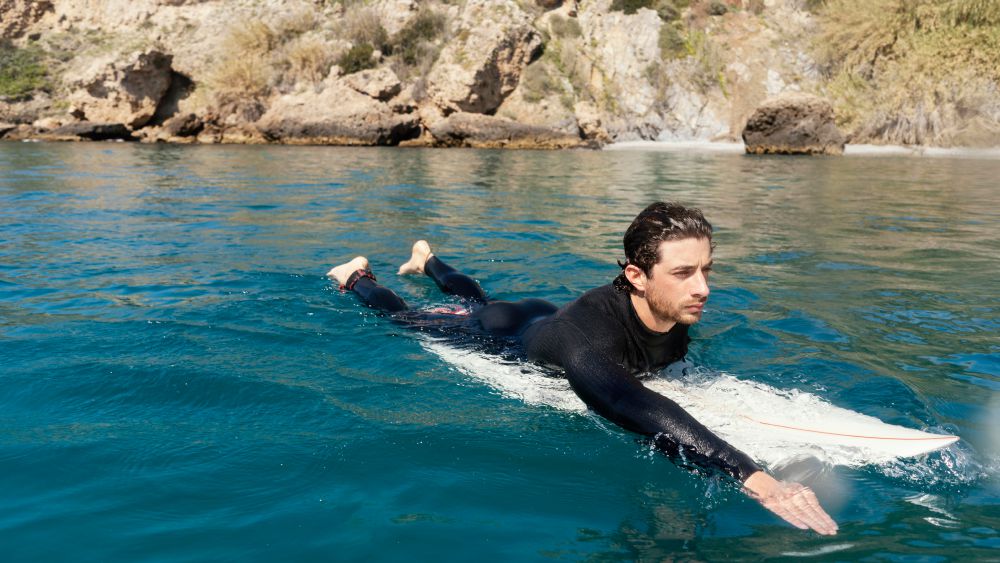
4. Use the Right Paddling in Surfing Technique
How to paddle well is to use the right paddling technique. Your strokes need to be smooth, deep, and powerful.
Use not just your forearm but your entire arm, from shoulder to wrist. Activate your back and core muscles, not just your arms. Keep your paddle strokes in a circular motion, entering the water near your nose and exiting near your hip. Avoid splashing, slapping, or digging into the water, as these actions waste energy and slow you down.
Ready to paddle stronger and surf better? Dive into our latest blog post for essential exercises for surfing paddling that will improve your surfing game.
5. Keep Your Head and Body Still
To paddle with precision, keep your head and body aligned with the surfboard’s direction. Overly head movement from side to side disrupts your balance and vision. Likewise, avoid twisting your body or lifting your hips, as this creates unnecessary drag and instability. Only look up when you need to check for incoming waves or assess the lineup.
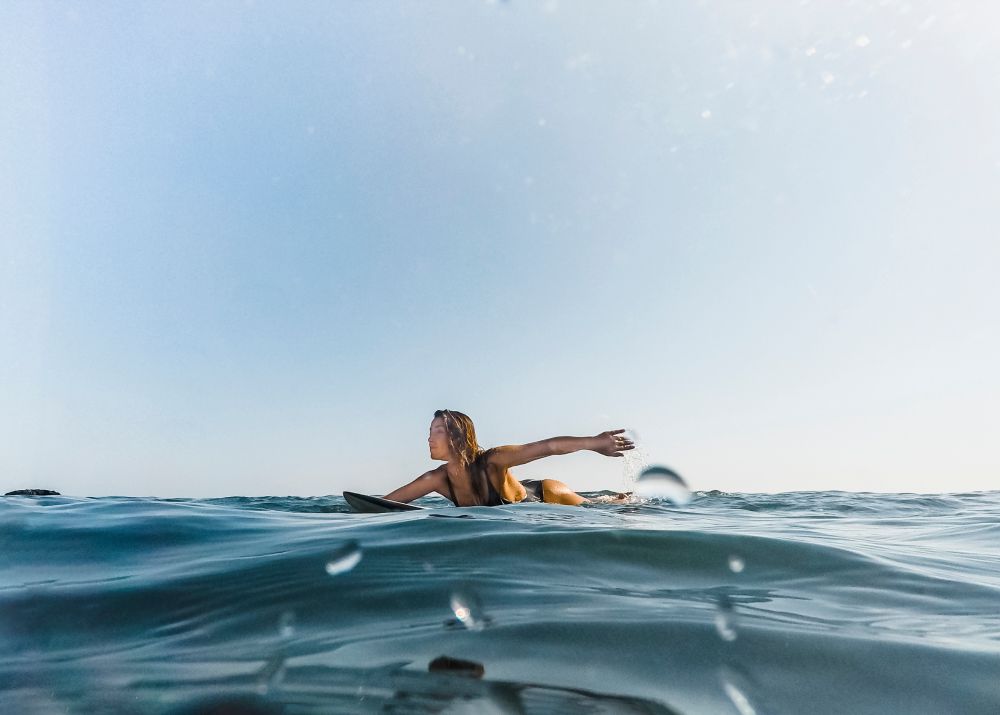
6. Breathe Properly
Now, let’s explore the next element of successful surfer paddling – proper breathing. To paddle effectively, remember to breathe deeply, rhythmically, and calmly. Inhale through your nose and exhale through your mouth. Avoid holding your breath, gasping, or panting, as these actions increase your heart rate and lead to fatigue. Additionally, steer clear of swallowing water, which can cause choking and coughing. Sync your breath with your paddling strokes, exhaling as your hand exits the water.
7. Time your Paddling
Next up in the journey to masterful surfer paddling is perfecting your timing. Maintain a steady, consistent paddling rhythm—avoid going too fast or too slow. Adapt your paddle speed to suit the wave conditions and your position. Speed up your strokes when it’s time to catch a wave, escape a rip current, or dodge obstacles. Conversely, slow down your paddling to conserve energy, rest, or patiently await that perfect wave.
8. Angle your Surfboard
When you’re paddle surfing, how you angle your surfboard makes a big difference, rather than aiming straight at the wave, angle slightly to the side. This approach helps you steer clear of the impact zone, where waves break, and positions you towards the shoulder, where waves form more smoothly. A well-angled surfboard aids in catching the wave at its optimal point, where it’s steeper and moves faster. To angle effectively, shift your weight a bit to one side and paddle more on the other.
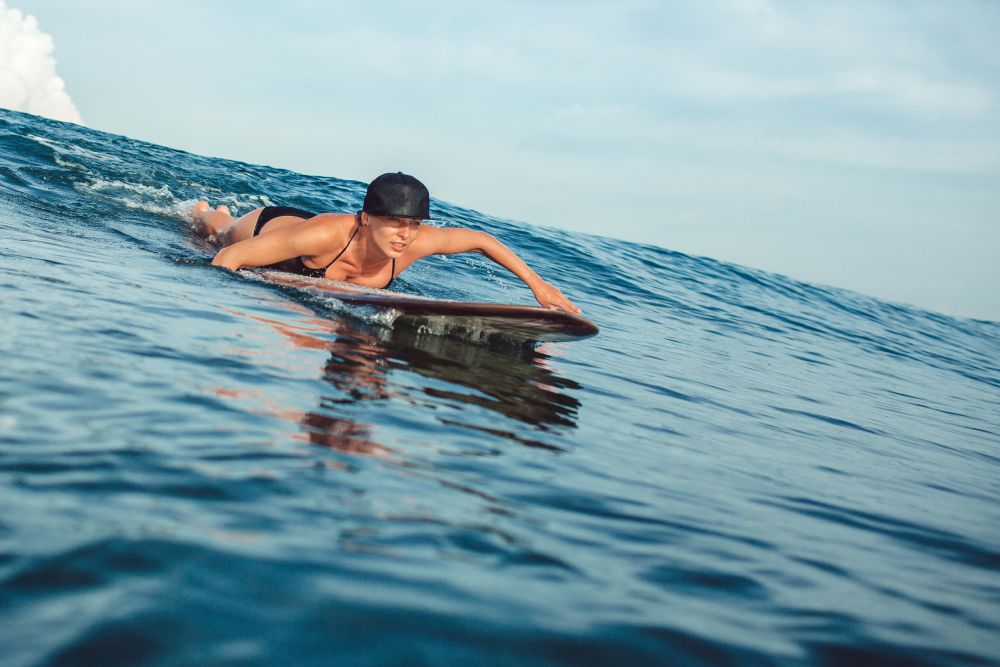
9. Duck Dive or Turtle Roll
In paddle surfing, tackling waves head-on is a skill that involves either a duck dive or a turtle roll. The duck dive, best for shorter surfboards, involves submerging yourself and the board under an incoming wave, and resurfacing on the other side. The turtle roll, more effective for longboards, requires you to flip your board and yourself underwater, allowing the wave to pass over before rolling back to your starting position. Learning these techniques is essential for a smooth and efficient paddle surfing experience.
10. Pop Up Quickly and Smoothly
When it comes to surfboard paddle techniques, surfers need to be perfect at the smooth pop-up. This move is when you seamlessly transition from lying on your surfboard to standing up. Timing is everything here – you want to pop up just as you feel the wave propelling you forward, not too early or too late. Make it a single fluid motion, avoiding any two-step processes. Start by placing your hands near your chest on the surfboard and push yourself up. Then, bring your feet beneath you, standing up in a balanced and stable position.
11. Paddle Back to The Lineup
In your journey to learn how to paddle surf, you need to know how to back to the lineup, where the waves are forming. Whether you just rode a wave or had a wipeout, you want to return swiftly and safely. Don’t waste time or energy. Paddle back following the same steps you used earlier but in reverse order. Keep an eye out for other surfers, watch the waves, and be aware of rip currents to avoid any problems.
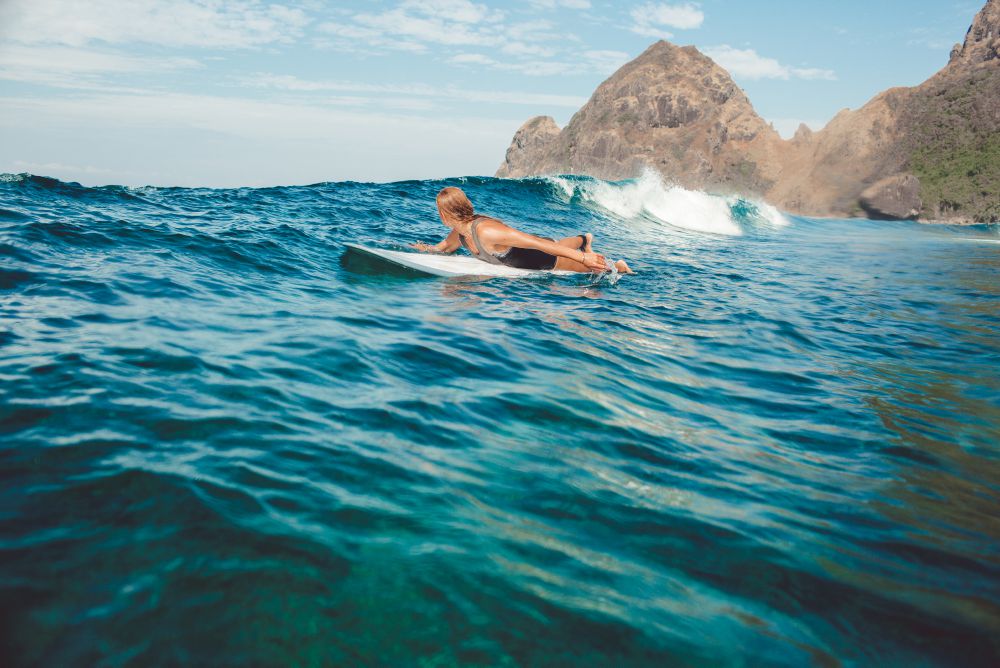
12. Paddle out of the Way
In paddling in surfing, safety is a top priority, and that means knowing when to get out of the way. If you see a wave or another surfer coming towards you, act fast and move quickly out of the way. The best move is to head towards the white water, where the wave has already broken, rather than paddling into the unbroken, green water area. Also, make sure to let other surfers know what you’re doing by signaling your direction, and don’t hesitate to apologize if you’re in someone’s path.
13. Paddle at a Normal Pace
Trying to paddle too quickly, like in a sprint, will only lead to exhaustion before you even reach the lineup. Instead, focus on long, smooth strokes that are steady. This approach helps you move quickly yet efficiently through the water.
14. Be Mindful of Your Stroke Follow-Through
During the ‘pull’ phase of your paddling, don’t extend your hands too far back. If you stretch your arms too much, it can actually slow you down. The right way is to pull your arms back just to the level of your chest, then lift them out of the water for the next stroke. Going beyond that point can make your board dip and lose speed.
15. Thumb Dragging Technique in Paddling
In paddling in surfing, a useful tip is to drag, or nearly drag, your thumbs through the water as you bring your hands forward for each stroke. The technique goes together with keeping your elbows high, which naturally positions your hands lower. You can avoid lifting your hands too high out of the water via this, which saves energy by not overworking your upper back muscles.
16. Leg and Feet Positioning
Resist the urge to kick your feet while paddling in surfing; contrary to what you might think, kicking can actually reduce your speed. For the best paddling condition, keep your feet together, aligning your ankles. Kicking shifts your weight forward too much, therefore, a still position of the feet ensures better balance and speed.
17. Using Your Spine Effectively in Surfing Paddling
Your spine is a central pole that helps balance your body when you’re paddling in surfing. As you paddle, your body will naturally rock a little from side to side with each stroke, similar to what happens in swimming. Such movement happens as you stretch your arms out to paddle. To get it right, picture a straight line running through your body from your head down to your tailbone. Also, you need to keep your head steady while you move your arms in each stroke.
How to Perfect Your Paddling in Surfing Techniques?
Now that we’ve covered the basics of paddling in surfing, let’s move on to refining your skills. Here are some tips on how to perfect your paddling techniques for an even better surfing experience.
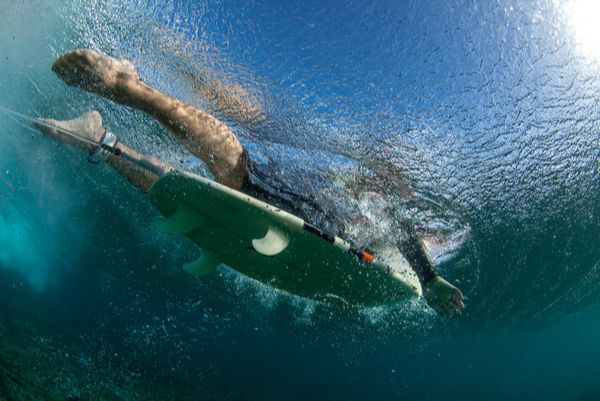
1. Reducing Drag While Paddling
Achieving efficient paddling involves reducing water resistance or ‘drag’. This requires locating the perfect position on the surfboard, known as the ‘sweet spot’, where you align correctly both vertically and horizontally. This alignment ensures minimal resistance as you move through the water, and it’s essential to be centered and balanced on the board for optimal paddling.
- Vertical Body Position in Paddling
Getting your vertical alignment right involves ensuring the surfboard is flat in the water, arching your back slightly, and keeping the board’s nose just above the surface. Your head should be up, eyes looking forward, with legs kept close together. Two common mistakes to avoid are reclining too far back, lifting the nose too high, and leaning too much forward, which submerges the nose.
- Horizontal Body Position in Paddling
Being horizontally centered and balanced is crucial. A good check is to lift your hands out of the water at the same time. If you tip to one side, your position needs adjustment. Lifting your head, which weighs around 20kg, can significantly lift the nose of the board. The ‘sweet spot’ is where the board lies so flat that slight changes in your position cause noticeable movements in the nose.
- Paddling Tips for Body Positioning
Imagine holding a soccer ball under your chin to maintain the right head position, keeping your back arched and minimizing resistance. Also, keeping your feet together aids in maintaining a horizontal position. Avoid using your legs to stabilize when uncentered, as this can slow you down and create more drag.
- Paddle Stroke Technique
Beyond positioning, your paddle strokes themselves are vital. Enter the water with your fingertips first, avoiding splashing for reduced drag. Aim for silent, smooth, and powerful strokes. Keep your head steady to minimize drag and maintain stability.
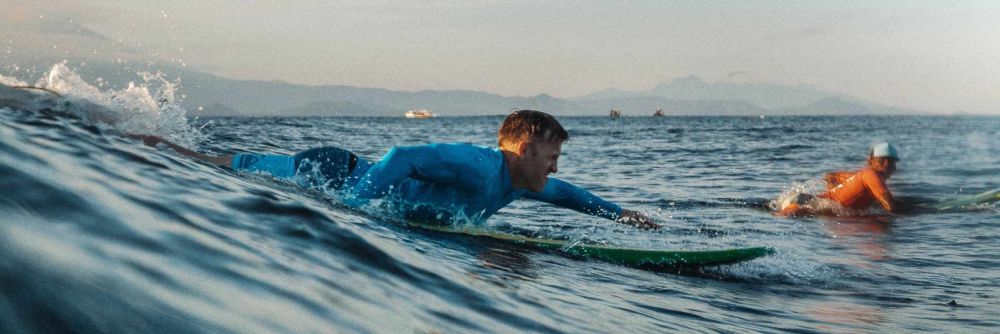
2. Enhancing Propulsion in Paddling
Maximizing propulsion is about efficiently moving water backward to propel forward. You can achieve this by mastering the proper paddling motion, which can be broken down into four phases:
- The Catch Phase
Start with your hand entering the water and extending your arm. The goal is to maximize the surface area, pushing water backward. Imagine hugging an imaginary log, achieving an ‘early vertical forearm’ (EVF) position with a high elbow and fingertips pointing down.
- The Pull Phase
Focus on pulling water backward for acceleration. Keep your hand and forearm aligned and perpendicular to the seabed, with a high elbow. Avoid bending your wrist or locking your shoulder, as it reduces the effectiveness of the pull.
- The Recovery Phase
After the pull, smoothly bring your arm out of the water, leading with the elbow. This motion should feel effortless, with the hand following the elbow out of the water.
- The Hand Entry Phase
Your hand should re-enter the water in front of your head and shoulder, aligned with the rail of your surfboard. Ensure the fingertips enter first to reduce drag, with the wrist higher than the fingertips and the elbow higher than the wrist.
Practice Tips for Maximizing Propulsion
- Keep a high elbow at key moments during your stroke.
- Try the fist drill, paddling with fists to focus on using your forearm.
- Feel the resistance on your hand and forearm; you should feel like you’re pulling yourself forward by pushing water backward.
Now that you know how to paddle on a surfboard, you may wonder how to perfect your paddling in surfing techniques. Here are some tips and tricks that will help you improve your paddling skills and performance:
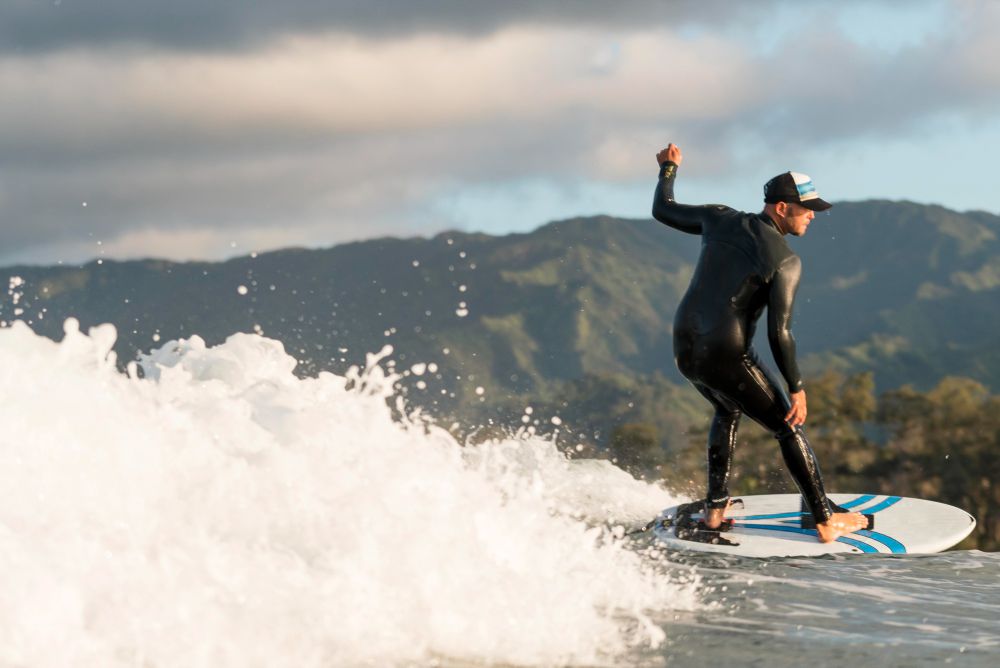
Choose Boost Fin to Catch More Waves
Ready to take your surfing to the next level? The Boost Fin is here to make that happen. It’s an awesome add-on that hooks up to any board in about 5 minutes. Here’s a quick rundown on why the Boost Fin is a must-have for surfers:
- Powerful Thrust: The Boost Fin packs a punch with a 20-pound thrust, similar to the power of 15 rowers in a canoe.
- Increased Speed for Wave Catching: The Boost Fin can boost your speed to up to 10 mph, making it easier and quicker to catch those perfect waves.
- Long-Lasting Battery Life: Enjoy longer surf sessions thanks to the Boost Fin’s battery, which lasts for 60–90 minutes on a single charge.
Quick Specs:
- Lightweight: Just 2.7 lbs, so it won’t make your board heavy.
- Durable Material: Built from Glass Fiber Reinforced Polymer and ABS Plastic for durability.
- High-Quality Battery: A Li-ion 3500 mAh, 24 V, 84 Wh battery ensures extended use.
- Efficient Remote Control: Comes with a 433 MHz remote for immediate responsiveness.
Boost Fin is an affordable way to upgrade your surfboard. While other electric fins can cost up to $1,000, the Boost Fin is just $499. It’s a sturdy, fast, and cost-effective way to make your surfing sessions more exciting.
Transform Your Surfing Experience with Boost Fin
Paddling significantly impacts how you catch waves, your overall surfing performance, and the enjoyment you get from the sport. Not to mention, effective paddling also contributes to your physical health and mental well-being.
For better skills in paddling in surfing, begin by doing a proper warm-up and focus on finding the most comfortable position on your board. The following steps involve practicing the right paddling techniques, making sure your strokes are well-timed and your board is positioned correctly for the waves. As you progress, focus on advanced techniques like reducing water resistance, improving your glide through the water, strengthening your paddling muscles, and continuously refining your technique for greater efficiency.
Boost Fin is designed to help you paddle more effectively, giving you the power and speed to catch wave after wave with ease. So why wait? Step up your surfing game with the Boost Fin.


Share:
Surf Etiquette: The Basic of Surfing Rules
How to Generate Speed Surfing on a Surfboard?